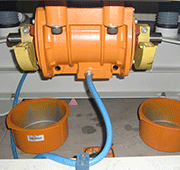E-Archive
Good Vibrations
in Vol. 15 - January Issue - Year 2014
The "Good Vibrations" Of The Future


The additional security to be put on the vibrating machines during the transport to maintain the tank pressed respect to the elastic support is shown


The dismounting of the motor vibrator for the eccentric masses adjustments is shown. As written in every instruction book, the power supply must be disconnected before proceeding with the adjustments
Europe, with the CE certification, has made an important step forward from the point of view of machine safety, with continued improvements in the norms. The risk assessment, in accordance with the Machinery Directive, with respect to an installation, is certainly "easy" to implement, or, at least, it is "easy" to understand the expectations that arises. However, it is anything but simple to answer the requirements of the Directive, especially considering the variety of the finishing systems and their many possible applications.
It seems appropriate to recall a phrase of Voltaire that clearly expresses the universe of risk assessment in the field of prevention: "What we call case is not and cannot be anything but the ignored cause of a known effect"...
Today, in the field of "mass metal finishing", some aspects are still left to a sort of "case" or, better, to a sort of primitive, essential phase. In fact, just for example, as far as the abrasive media is concerned, the field of "mass metal finishing" has not yet been considered, from the point of view of standards definition and unification, in a serious and international way, as in the neighbouring fields of surface finishing. Just to make an example, in the field of grinding belts, the grades of abrasives are identified according to ANSI Mesh (American National Standards Institute), or to FEPA standards (Federation of European Producers of Abrasives). What about a plastic media or a ceramic media for mass metal finishing?
One believe that the correct identification of a media, from the technical point of view (not only from the sterile "safety" datasheet), would be preparatory for a much wider consideration of the correct use of the media in the context of the "finishing process". In fact, considering the "risk analysis", it is important to have the most correct definition of an abrasive (or a media) from all possible points of view. One example is the risk of silicosis and asbestosis coming from the improper use of a normal plastic media without water (many plastic media are formulated with silica abrasives).
Let’s imagine, for example, the finishing of magnesium composites, in case of absence of water, or in case the user decides to use a dry process, with the production of a high concentration of magnesium particles. From the point of view of ATEX norms, this is the beginning of an explosive area of high risk.
Unlike a machine tool, a machine for mass metal finishing has not only a single "mission", but a long list of possible "finishing processes", which is extremely complex.
A "finishing process" is the result of the combination of multiple factors, like finishing machines, finishing media, finishing compound, water, water treatment compound, the material of the workpieces that, in spite of the commonly used "mass metal finishing" definition, are not made only of metal, but can be also constructed in elastomer, polymer, mineral, ceramic, glass, wood, corn, etc.
Of course, the possibility of combinations is so wide, that there could be other factors, like a dry process, a self-barrelling process, etc., so the above list of possible "combinations" of elements is only indicative and not exhaustive. The need to match the several process combinations with suitable "risk evaluation and prevention", considering the evident diffusion of MMF worldwide, could be a smart and serious target for the future of MMF.
The task of the manufacturer is to identify the intended use and to assess all risks associated with the system, while also forecasting potential improper and inconsistent uses that are often unknowingly implemented by the end user. As said, in the field of the finishing process, this evaluation is complex and, sometimes, difficult. Its complexity is due to the many fields of application, and to the numerous products that may be associated with the finishing system, according to the process that determines the finishing result.
The rules are there; they need to be put in the hands of everyone's experience, to apply them in the correct way. The step towards a standardization of the products, especially in the field of abrasives and chemicals, is certainly a first way to go; however, with the aim of increasing the level of safety, it is necessary to deepen the technical evaluations during the design and definition of the field of application, by analyzing and preventing the possible and potential risk scenarios thanks to the technical knowledge and experience gained through years of applications.
It would be desirable, after standardization of abrasive products, that the establishment of a committee or of a federation or another entity be carried out, that establishes the criteria for evaluating and identifying the hazards causing the resulting levels of risk.
One possible way, although challenging, would be to combine the experiences and establish a working group that deals with "only" safety... on the contrary, it often happens that the technicians are involved "also" with Safety!
Good Vibrations
by Paolo Redaelli
Contributing Editor MFN and
Rollwasch® Italiana S.p.a.
Tel. +39.0362.930 334
Fax +39.0362.931 440



























